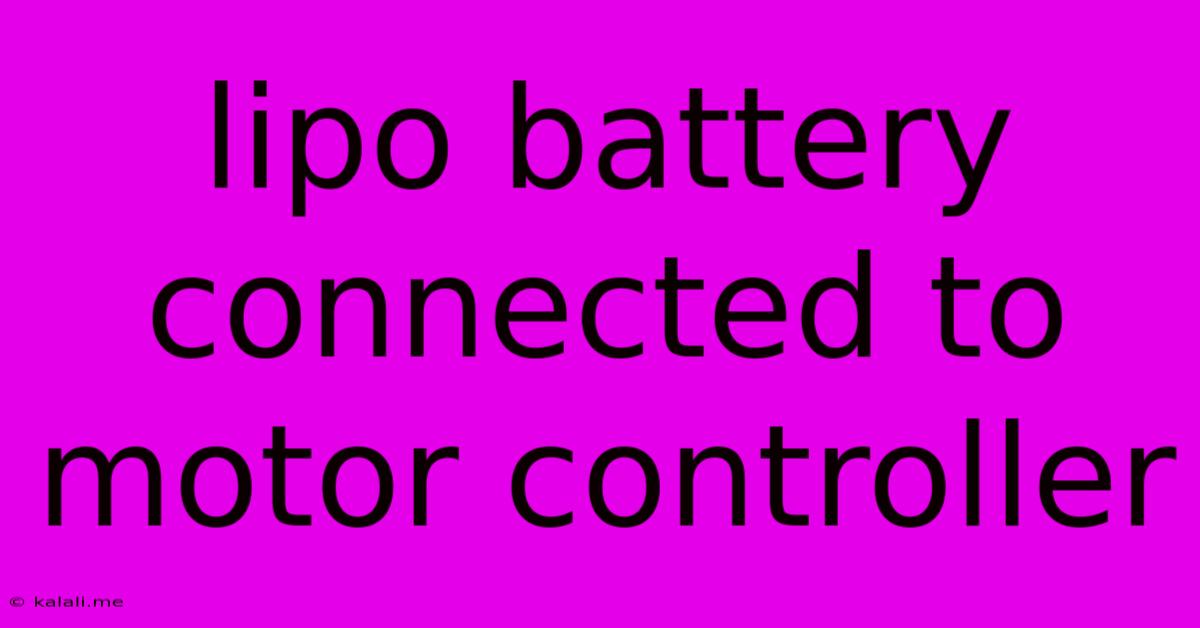Lipo Battery Connected To Motor Controller
Kalali
Jun 06, 2025 · 3 min read

Table of Contents
Connecting Lipo Batteries to Motor Controllers: A Comprehensive Guide
Meta Description: Learn how to safely and effectively connect lithium polymer (LiPo) batteries to your motor controller, covering voltage matching, wiring techniques, and essential safety precautions. This guide covers everything from basic principles to advanced considerations for optimal performance.
Connecting a LiPo battery to a motor controller is a crucial step in powering any electric vehicle or robotic project. Understanding the process correctly is vital for both optimal performance and safety. This guide will walk you through the entire procedure, covering essential aspects like voltage matching, wiring techniques, and crucial safety measures. Improper connections can lead to damage to your equipment or even a fire, so careful attention to detail is paramount.
Understanding LiPo Batteries and Motor Controllers
Before diving into the connection process, let's briefly review the key components:
-
LiPo Batteries: Lithium Polymer batteries are rechargeable batteries known for their high energy density and lightweight nature. They are popular in various applications, including drones, RC cars, and robotics. However, they require careful handling due to their potential for fire if mishandled. Understanding their voltage (e.g., 3.7V per cell, typically arranged in series for higher voltages like 7.4V, 11.1V, or 14.8V) is crucial.
-
Motor Controllers (Electronic Speed Controllers or ESCs): These are electronic circuits that regulate the power supplied to a motor, controlling its speed and direction. Different motor controllers are designed for different motor types and voltage ranges. It's critical to match the controller's voltage rating to the battery's voltage output to avoid damage.
Matching Voltage: The Foundation of Safe Operation
The most important factor before connecting your LiPo battery is voltage compatibility. The motor controller must be rated for the voltage output of your LiPo battery. Connecting a higher voltage battery to a lower voltage controller will almost certainly damage the controller. Conversely, using a lower voltage battery may result in insufficient power and poor motor performance. Always check the specifications of both your battery and motor controller carefully.
Wiring Techniques: Ensuring a Secure and Efficient Connection
Once you've confirmed voltage compatibility, you can proceed with the wiring. Here's a breakdown of the process:
-
Identifying Terminals: LiPo batteries typically have positive (+) and negative (-) terminals clearly marked. Motor controllers also have corresponding terminals, often labeled "Battery +" and "Battery -".
-
Using Appropriate Connectors: Use high-quality connectors designed for the amperage of your system. Common choices include XT60, XT90, and Deans connectors. Ensure a secure connection to prevent voltage drops and potential sparking.
-
Soldering (Optional): While connectors offer easy connection and disconnection, soldering can provide a more robust and reliable connection for high-current applications. However, soldering LiPo batteries requires extra caution and expertise to prevent damage to the cells.
-
Wiring Diagram: Always consult the wiring diagrams provided with both your LiPo battery and motor controller. Incorrect wiring can lead to component failure or even fire.
Safety Precautions: Prioritizing Safety Above All Else
Working with LiPo batteries requires strict adherence to safety measures:
-
Use a LiPo Bag: A fire-resistant LiPo bag can help contain any potential fire or explosion.
-
Proper Charging: Always charge LiPo batteries using a suitable and calibrated LiPo charger.
-
Avoid Over-Discharge: Monitor the battery voltage during operation to prevent over-discharge, which can damage the battery and create safety hazards.
-
Proper Storage: Store LiPo batteries in a cool, dry place away from flammable materials.
-
Never Short-Circuit: Never directly connect the positive and negative terminals of a LiPo battery together.
Advanced Considerations: Optimizing Performance
For more advanced users, understanding concepts like C-rating (discharge rate) and the motor's current draw can help optimize performance. Ensure the battery's C-rating is sufficient to supply the current required by the motor at its peak load.
Conclusion:
Connecting a LiPo battery to a motor controller requires careful planning, precise execution, and a strong emphasis on safety. By following the guidelines outlined in this guide, you can ensure a secure and efficient connection, enabling optimal performance of your electric vehicle or robotic project. Remember: safety should always be your top priority.
Latest Posts
Latest Posts
-
Factors Of That Add Up To
Jun 07, 2025
-
Burnt Milk On Glass Stove Top
Jun 07, 2025
-
Word For When You Spot Something Wrong
Jun 07, 2025
-
How To Clean 3d Printer Bed
Jun 07, 2025
-
What Happens If You Eat Raw Jimmy Dean Sausage
Jun 07, 2025
Related Post
Thank you for visiting our website which covers about Lipo Battery Connected To Motor Controller . We hope the information provided has been useful to you. Feel free to contact us if you have any questions or need further assistance. See you next time and don't miss to bookmark.